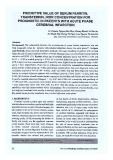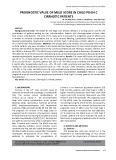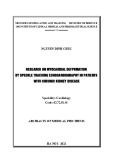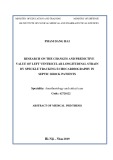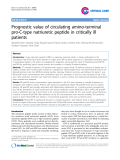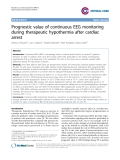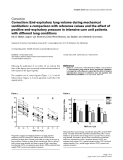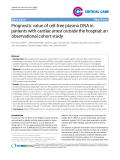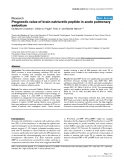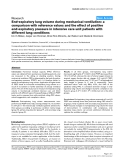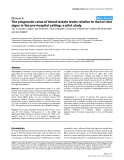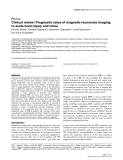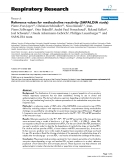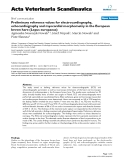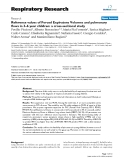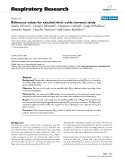
HUE JOURNAL OF MEDICINE AND PHARMACY ISSN 3030-4318; eISSN: 3030-4326
178
Hue Journal of Medicine and Pharmacy, Volume 14, No.6/2024
Research of the normal reference values of right ventricular
longitudinal strain indices in healthy adults using 2D speckle-tracking
echocardiography
Tran Thanh Dat1, Hoang Anh Tien1, Nguyen Thi Thuy Hang1*
(1) University of Medicine and Pharmacy, Hue University
Abstract
Background: Although right ventricular strain indices obtained from speckle-tracking echocardiography
have prognostic value in cardiovascular diseases, normal reference values remain unclear and vary between
different manufacturers and software. In Vietnam, there have been no studies addressing this issue. This study
aims to determine the reference values of the two strain indices, RVFWLS and RVGLS, and to explore their
relationship with age and gender. Method: A total of 132 healthy adults (>18 age) with no medical history
of cardiovascular diseases and other internal diseases, who met all inclusion criteria were fully assessed,
including clinical assessment, laboratory measurements, and ECG examination. In addition, all participants in
our study underwent transthoracic echocardiographic examination, including both conventional parameters
and right ventricular strains. Results: The reference values for right ventricular free wall longitudinal strain
(RVFWLS) and right ventricular four-chamber longitudinal strain (RV4CLS) are -28.09 ± 3.47 and -24.90 ± 3.05,
respectively. The absolute values of RVFWLS and RV4CLS are higher in females than in males, with values of
-29.35 ± 3.37 and -26.10 ± 3.04 for females, compared to -26.58 ± 2.97 and -23.47 ± 2.39 for males, respectively,
which are statistically significant (p<0.001). Age shows a positive correlation with both RVFWLS and RV4CLS,
with correlation coefficients of r = 0.218 and r=0.237, respectively, and statistical significance of p<0.05 and
p<0.01. Conclusion: The index RVFWLS and RV4CLS using speckle-tracking echocardiography are significantly
higher in females than in males (p<0.001). Therefore, caution should be exercised when using these values in
clinical practice.
Keywords: right ventricular strain, Reference values, Speckle tracking echocardiography.
Corresponding Author: Nguyen Thi Thuy Hang. Email: ntthang@huemed-univ.edu.vn
Received: 25/9/2024; Accepted: 24/11/2024; Published: 25/12/2024
DOI: 10.34071/jmp.2024.6.25
1. INTRODUCTION
Right ventricular function was previously
overlooked, and research on the right ventricle was
limited. However, in recent years, with advancements
in interventional cardiology and imaging diagnostics,
the structure and function of the right ventricle have
received increased attention [1-2].
The assessment of right ventricular systolic
function plays a crucial role in the diagnosis,
prognosis, and treatment of various cardiovascular
diseases. Common parameters used to evaluate
right ventricular function, such as right ventricular
strain (RVS), right ventricular fractional area change
(RV FAC), tricuspid annular plane systolic excursion
(TAPSE), and pulmonary artery systolic pressure
(PAPs), measured by 2D echocardiography and
Doppler tissue imaging, are influenced by right
ventricular overload pathologies and are dependent
on the imaging angle, which can lead to inaccuracies
[1-3]. Speckle-tracking echocardiography (STE) can
mitigate these limitations by being less affected
by imaging angles and right ventricular load
abnormalities. It also helps overcome the challenges
posed by the right ventricle’s complex structure and
passive movement.
Strain is a dimensionless parameter calculated
from the change in length between two points
before and after movement. With some technical
advancements, myocardial strain can be measured
using ultrasound imaging and has been integrated
into clinical practice to provide a non-invasive and
objective indicator of myocardial contractility.
Myocardial strain reflects both the regional and
global systolic function of the myocardium. Estimated
strain values from 2D echocardiography are strong
prognostic factors for various cardiovascular diseases.
They can detect subclinical myocardial changes at an
early stage and may serve as prognostic indicators for
multiple cardiovascular conditions [2].
Numerous studies have demonstrated that
longitudinal strain indices of the right ventricle
are crucial for diagnosing and prognosticating
cardiovascular conditions such as pulmonary
hypertension, arrhythmogenic right ventricular






